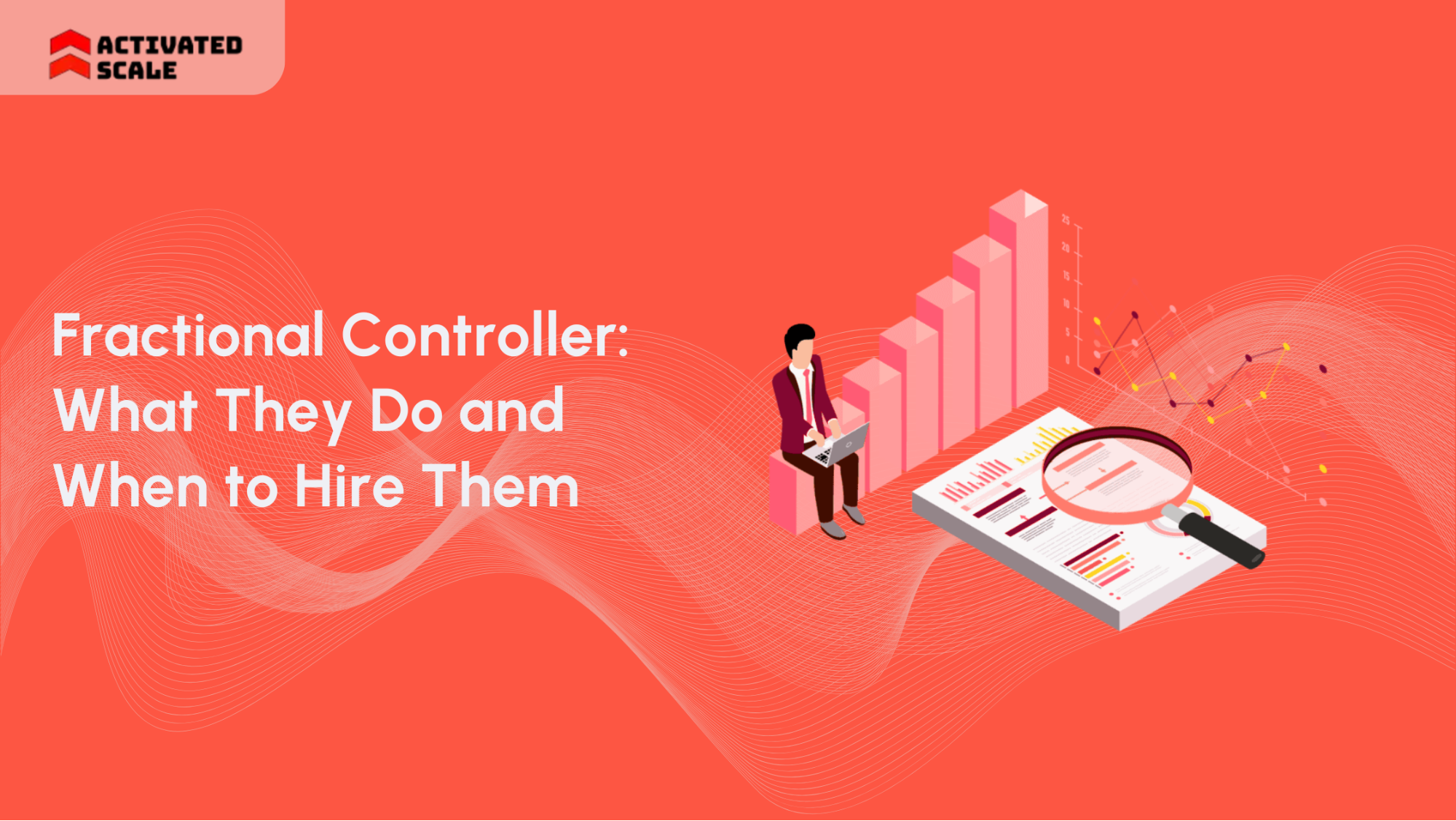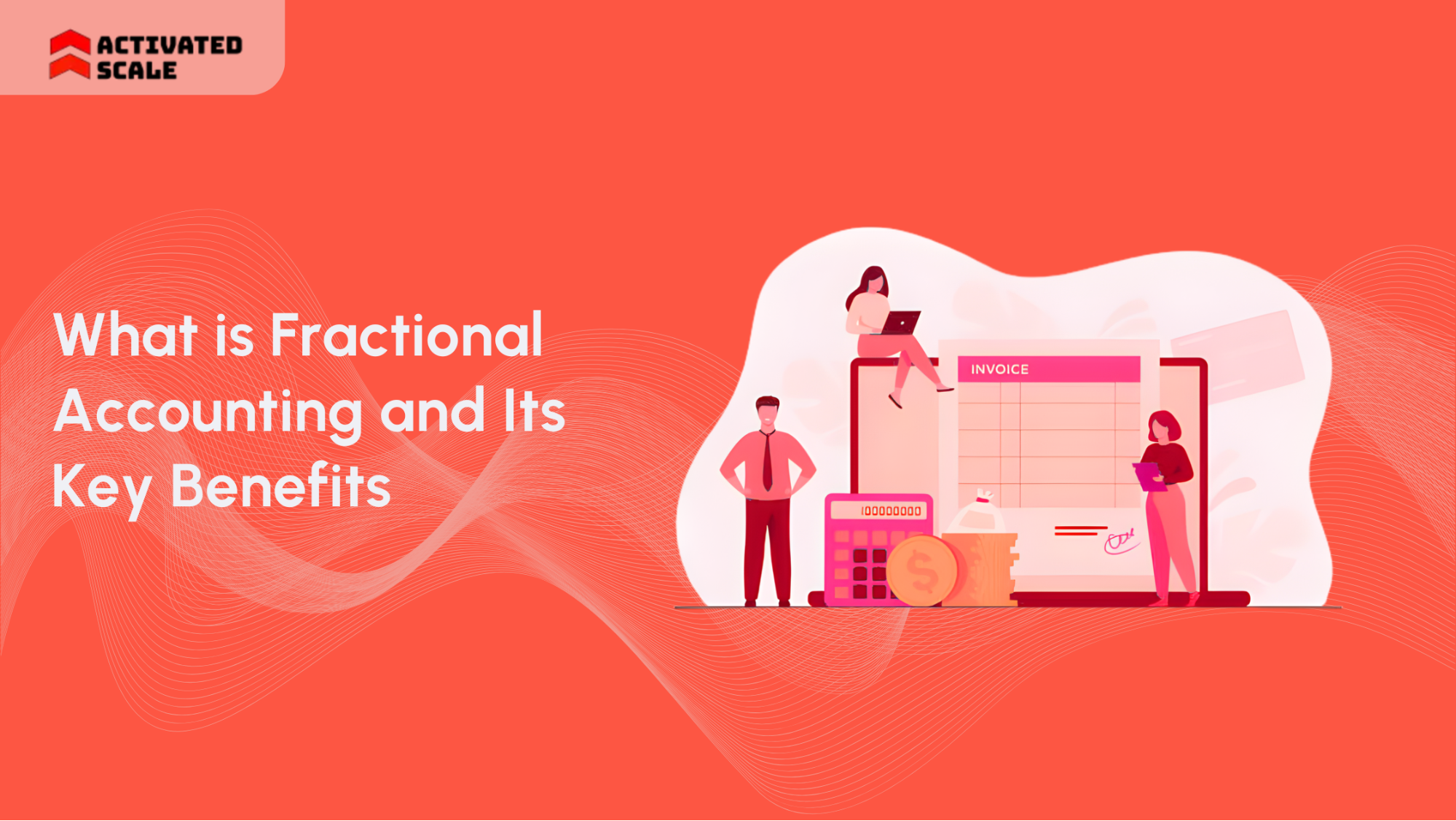Budgets are tight, yet growth targets rise each quarter. Suppose your budget is fixed at 7.7% of revenue, but your goals aren't; you can't afford to waste a single dollar.
The only path forward is to focus on what delivers the highest returns and build a marketing engine that can shift direction quickly.
Most importantly, you’re not just a budget manager. Your work revolves around the responsibilities of a founder, a revenue leader, and a B2B marketer. We hear you.
This guide is for you. We're breaking down how a fractional marketing agency acts as your strategic pressure-release valve. It’s the model that gives you an elite, data-obsessed team on demand, without the full-time price tag.
We’ll also walk you through how to pick the right partner and the common pitfalls to turn budget into your biggest advantage.
Quick Look
- Scaling your marketing doesn’t have to mean high costs or long hiring processes. With a marketing agency, you gain access to seasoned professionals without committing to full-time hires.
- The power of flexibility is that fractional marketing agencies let you scale up or down as your business needs shift.
- Waiting months to see results isn’t an option. Fractional marketing agencies allow you to hit the ground running, delivering measurable results in weeks.
- Fractional agencies bring a wide range of expertise. From SEO and content creation to paid media and analytics, they ensure specialists cover every part of your strategy.
- Proving your marketing efforts are working doesn’t have to be a mystery. With fractional agencies, you set clear KPIs and run time-boxed tests to see exactly how each initiative is performing.
What is a Fractional Marketing Agency?
Many marketers still lack real-time data for key work. A fractional marketing agency supplies senior marketers on a flexible model. The team works part-time or per project.
Common engagement types include three formats:
- Sprint teams run 8–12 week audits and launch plans.
- Part-time retainers guide the roadmap, creative, and channels.
- Project pods ship defined deliverables, then roll off.
The core deliverables span growth functions: Go-to-Market strategy, search engine optimization (SEO), and conversion rate optimization. Teams also handle reporting, analytics, and attribution setup to connect spend to revenue.
The Benefits are:
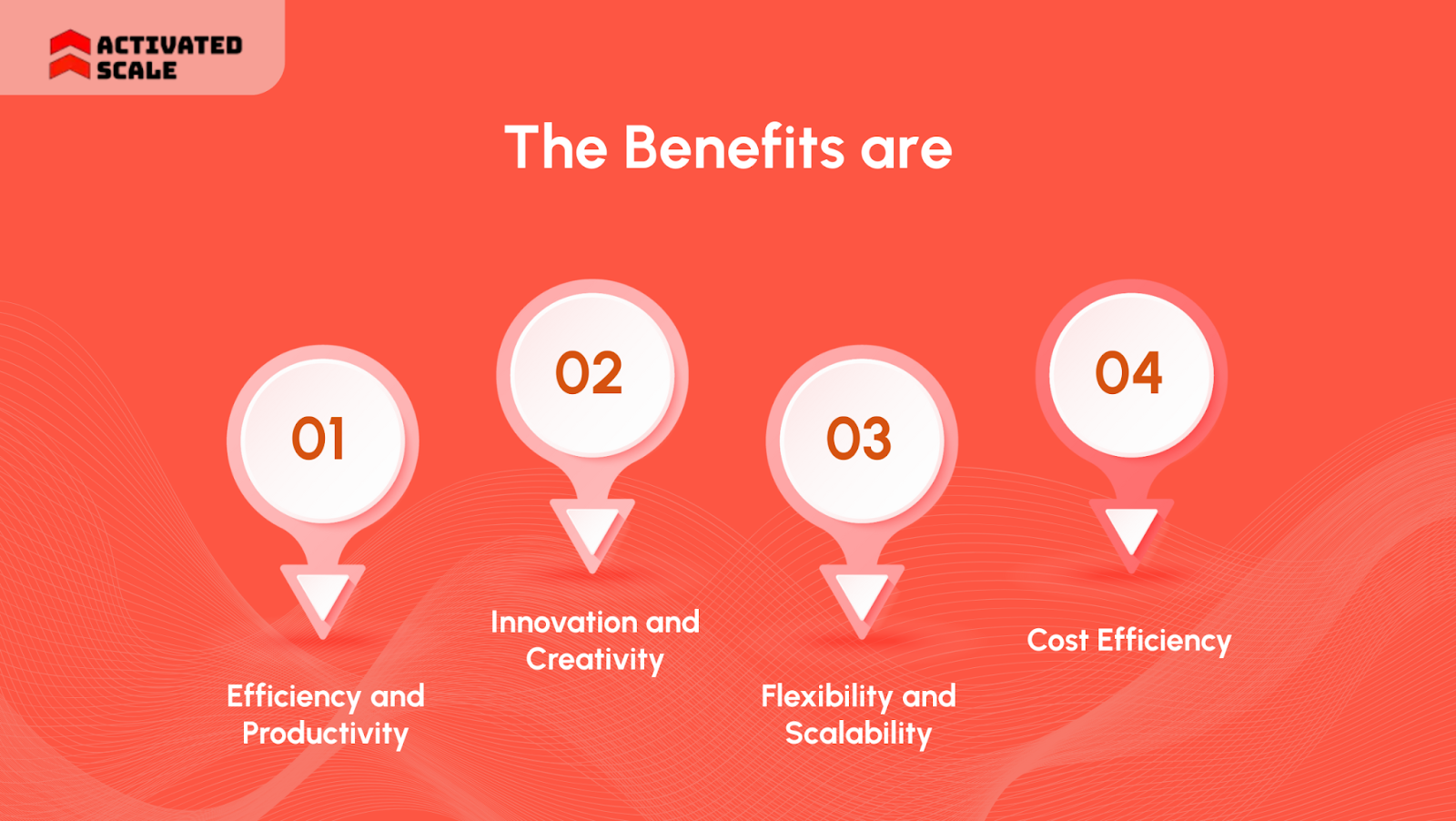
The fractional model is designed to inject seasoned leadership and specialized skills directly into your workflow. This translates into four powerful advantages for your business. What are those?
The facts at a glance:
1.Efficiency and Productivity
Internal teams hit capacity during peaks. Work queues grow and timelines slip. The agency adds a pod that owns projects and reporting. A "pod" refers to a small, specialized, and cross-functional team that works together on specific projects or tasks.
It includes a strategist, a designer, content creator, and an analytics specialist, who collaborate to execute a defined set of marketing goals or campaigns. Activation speeds up because the team is already trained.
2. Innovation and Creativity
Fresh eyes spot waste and new tests faster. The agency rotates specialists who bring patterns from other markets. That cross-pollination fuels better ideas with less risk.
3. Flexibility and Scalability
Agency lets you scale support without fixed headcount. Start month-to-month and adjust scope as needs change. Shift hours toward launches, then taper for maintenance. Budgets stay fluid while output stays steady.
4. Cost Efficiency
Fixed salaries become variable services. Agency aligns hours to goals and stages. So, the spend follows results, not titles.
But how does this model compare with hiring a fractional chief marketing officer (CMO) or an in-house team?
Read Also: Top Benefits of Hiring a Fractional CMO for Your Startup
How Does a Fractional Marketing Agency Differ from Other Alternatives?
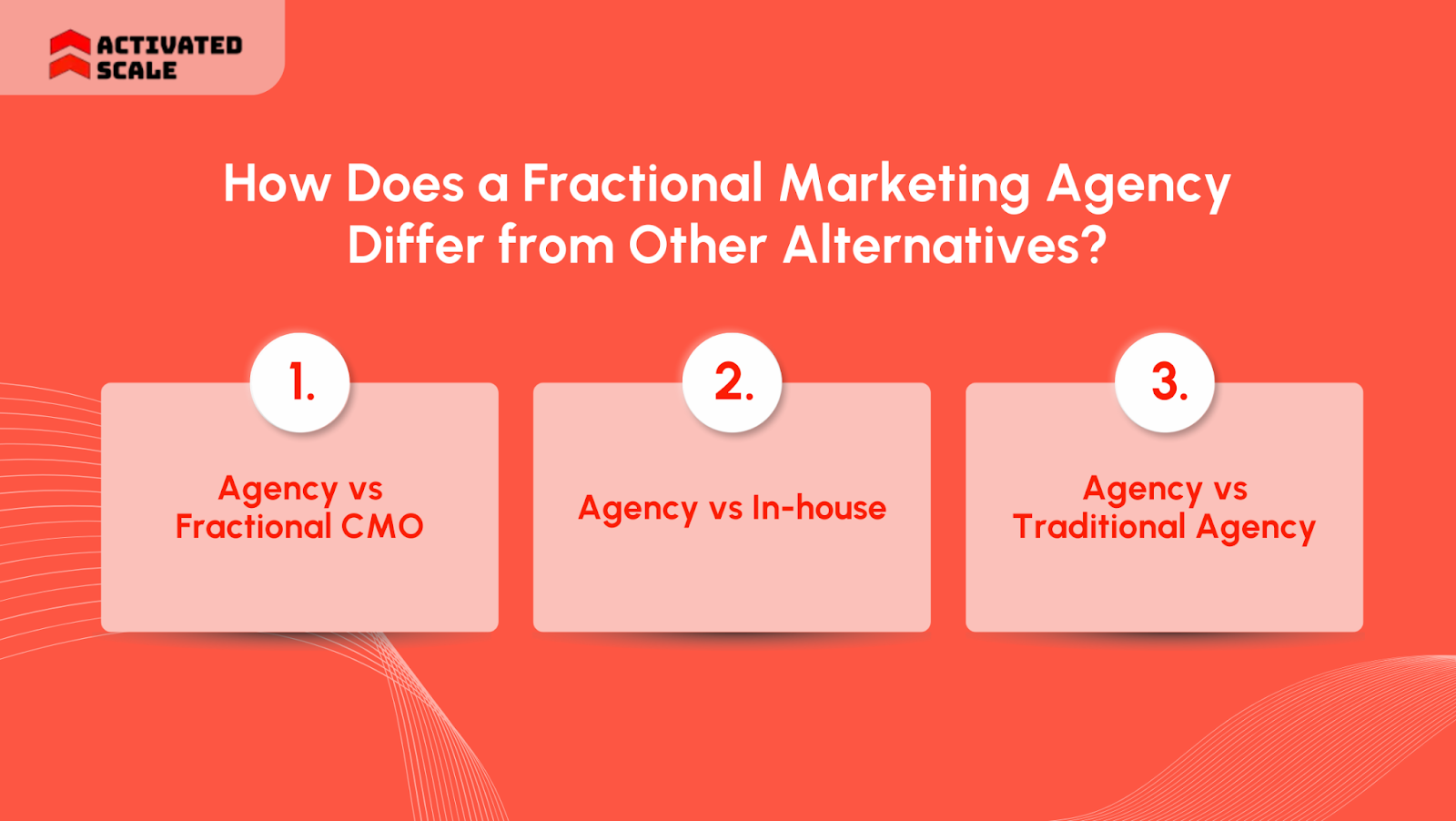
You’re tired of the false choice: The blinding speed of a generic freelancer or the expensive expertise of a traditional agency.
What if you could have a hybrid that gives you the best of both, without the downsides?
The good news is, you certainly can do it.
However, you need to be assured about the differences among your picks. Here’s what you need to know:
1. Agency vs Fractional CMO
A pod brings hands and breadth across channels. A fractional CMO brings senior ownership and cross-functional alignment. Pods excel when execution stalls. A senior owner helps when the team lacks direction and prioritization.
Many firms pair both for speed and clarity. In fact, in 2025, CMOs and agency executives will combine full-funnel coverage with deep craft expertise across channels. That mix favors modular pods led by senior owners.
Note: Use an agency when you need production plus strategy in one team.
2. Agency vs In-house
Pods start in days and scale skills by need. In-house hires add depth and tribal knowledge but raise fixed costs and hiring time. Usually, spending data reflects why leaders seek flexible capacity rather than permanent load.
Note: Choose an agency when deadlines loom and coverage gaps block delivery.
3. Agency vs Traditional Agency
Pods shift scope and swap specialists without long renegotiations. Traditional firms often bundle services and add layers before work moves. Across the industry, agencies are recasting offers into productized, AI-enabled solutions.
Note: Pick an agency when you want modular teams and faster changes.
Quick Overview of the Fractional Marketing Agency Vs Alternatives:
Need proven sellers without adding headcount? Try Activated Scale’s Fractional Selling service with vetted senior development representatives (SDRs). Pair our Fractional Selling team with your chosen marketing agency to drive pipeline and revenue.
You now have a clear view of trade-offs across cost, speed, expertise, and integration. The next step is knowing the exact moments to switch models.
When to Hire a Fractional Marketing Agency?
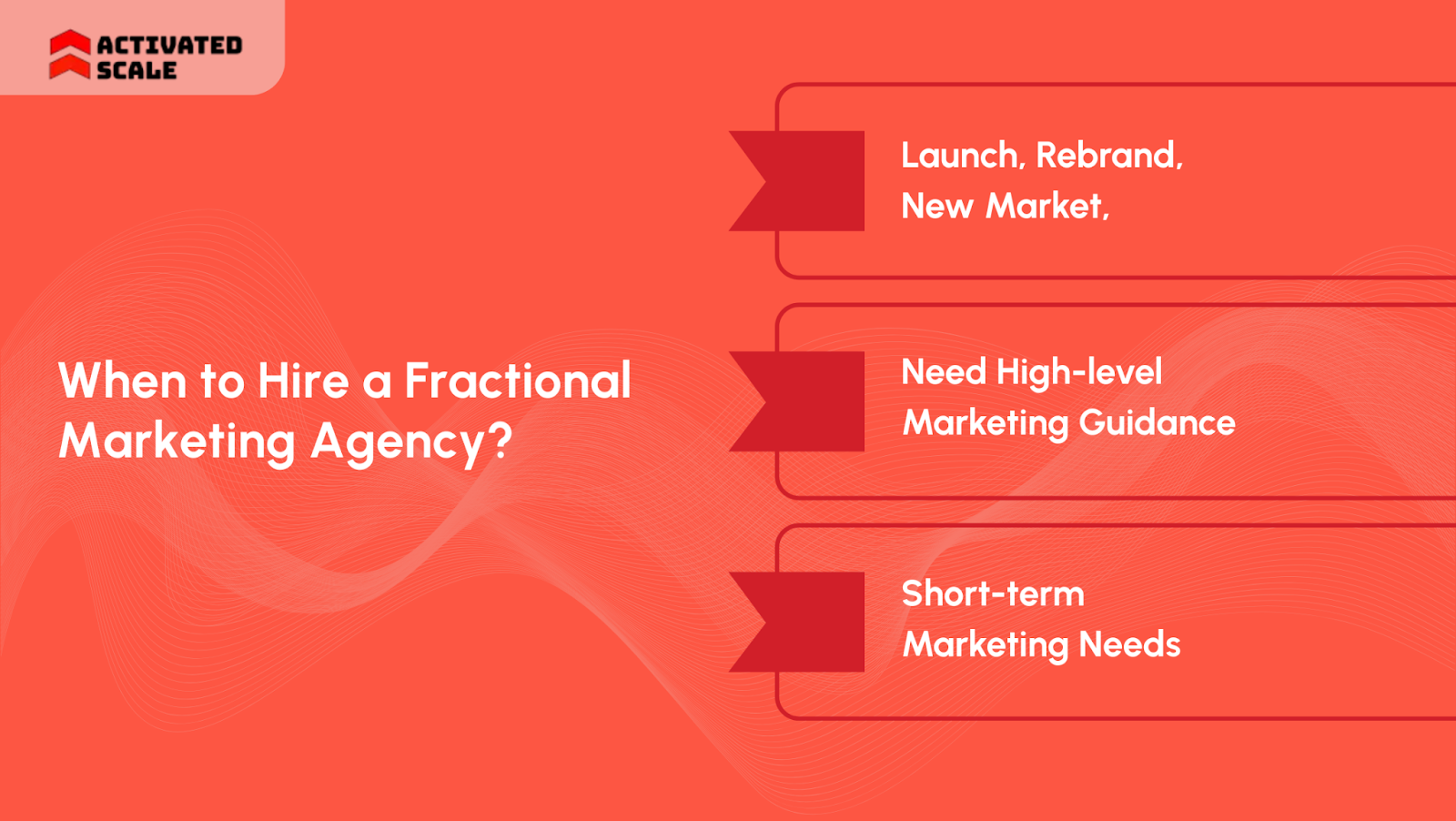
Teams stall for predictable reasons. Hiring takes time. U.S. averages hover near 36 days to fill a role. Urgent goals rarely wait that long. Hurdles like these add up and block revenue moves.
To avoid this, we’ve listed a few situations for you that will help you decide whether you need an agency or not:
1. Launch, Rebrand, New Market, or Channel Gaps
Big milestones need focused crews. Bring in an agency to run GTM, creative, and paid together. Add SEO and lifecycle so handoffs do not stall. Run the crew through a 90-day arc tied to pipeline goals.
2. Need High-level Marketing Guidance
When strategy lacks clarity, bring senior direction with the same crew that executes. An agency aligns positioning, offers, channels, and measurement. The same team owns the plan and the outcomes.
3. Short-term Marketing Needs
Some initiatives should not trigger headcount. Examples include a pricing rollout, a product splash, or an attribution rebuild. The agency delivers the work, documents the playbooks, and exits cleanly.
So, where does this leave you? With the pros and cons laid out, you're equipped to make an informed choice that truly fits your company's pace and ambition.
Read Also: Understanding The Role and Benefits of a SaaS Fractional CMO
How to Choose the Right Fractional Marketing Agency?
Selecting a partner should feel structured. Start with a simple scorecard, then run light due diligence. Afterward, finish with a tooling check. In this section, we understand how leaders want proof before spending.
So, below is your go-to guide:
1. Scorecard
Use a five-point scale for each metric. Mention the fractional agency phrase in your request for proposal (RFP). Vendors who lead with pods, pilots, and dashboards usually fit this model.
- Industry fit: Do they show work in your market? HubSpot’s agency checklist suggests a report card format.
- Case proof: Look for clear baselines, targets, and outcomes. Ask for dates and live URLs.
- Operating cadence: Weekly standups, monthly reviews, and a named owner.
- Teaming model: Solo lead vs cross-functional pod. Match to your gaps.
- Terms: Month-to-month first, then step-ups tied to results.
- Culture: Direct comms, tight feedback loops, and shared docs.
2. Due diligence
A marketing agency that passes the checks below is far less likely to miss targets. Link the pilot to one owner and a weekly review.
- References: Ask for two in your segment. Confirm goals, start date, and lift.
- Sample dashboards: Request redacted views with metric trees and definitions.
- Pilot sprint: Run 6–8 weeks with success criteria.
- Work samples: One ad set, one landing page, one report. Date-stamped.
3. Tooling Fit
Map your stack on one page. List customer relationship management (CRM), SEO, and email tools. Ask for setup steps and migration notes.
- CRM/MAP (Marketing Automation Platform): HubSpot or Salesforce are common. Confirm skills and admin access.
- Analytics: Agree on KPI names and dashboard refresh times. Salesforce help docs cover report performance tips.
- SEO and Content: Confirm access to CMS and keyword tools.
- Email and Lifecycle: Confirm templates, segments, and sending domain control.
Need a sales arm to match your new fractional marketing agency? Pair the plan with our Fractional Sales Leadership service so the pipeline does not stall. At Activated Scale, we connect companies with vetted and experienced US-based Sales Talent.
So, what are a few top leading marketing agencies that could fit the above checkpoints? Don’t worry. The section below will help you with that.
Top 5 Fractional Marketing Agencies You Need to Know About

You have the growth goal, but not the full-time team to get there. This is the precise gap a top-tier fractional agency fills. Based on their proven results, the five partners listed below stand out for their operational flexibility:
1. Flying V Group
Flying V Group is a go-to fractional marketing agency for businesses seeking flexible, high-level support. Known for its versatile approach, Flying V integrates into your team and delivers results that matter.
Services:
- Fractional CMO
- Digital marketing strategy
- Paid media management
- Content creation and marketing
- Lead generation
2. Digital Authority Partners (DAP)
Specializing in industries like healthcare, software-as-a-service (SaaS), and legal services, DAP is a powerhouse in digital marketing. With a data-driven approach, DAP scales startups rapidly while ensuring high ROI (return on investment).
Services:
- SEO and pay-per-click (PPC) management
- Content marketing and strategy
- Website development and UX
- Lead generation
- Marketing analytics and reporting
3. Authentic Brand
Authentic Brand’s fractional CMOs help SMBs bridge the gap between strategic vision and tactical execution. Their Authentic Growth™ Methodology allows companies to build marketing infrastructures that scale sustainably.
Services:
- Fractional CMO services
- Strategic planning and execution
- Brand development
- Content marketing
- Market research and customer insights
4. CMOx
CMOx specializes in transforming underperforming marketing departments into high-performing, results-driven engines. They’re known for their functional marketing framework and expertise in optimizing KPIs and campaign efficiency.
Services:
- Fractional CMO
- Marketing strategy and optimization
- Campaign management
- Key performance indicators (KPIs) tracking and reporting
- Team leadership and development
5. House of Revenue
Based in Denver, House of Revenue focuses on building scalable marketing and sales systems that drive sustained growth. Their focus on revenue operations guarantees every marketing dollar is spent effectively.
Services:
- Fractional CMO and chief revenue officer (CRO)
- Marketing automation
- Lead generation and nurturing
- Revenue operations
- Inbound marketing strategy
The flexibility of a fractional agency is a tremendous asset, yet this very strength can create unique challenges. Before you begin, it's crucial to understand the potential friction points so you can handle them with ease.
Also Read: Should You Hire a Fractional CMO? Key Considerations
Challenges & Fixes While Working With a Fractional Marketing Agency
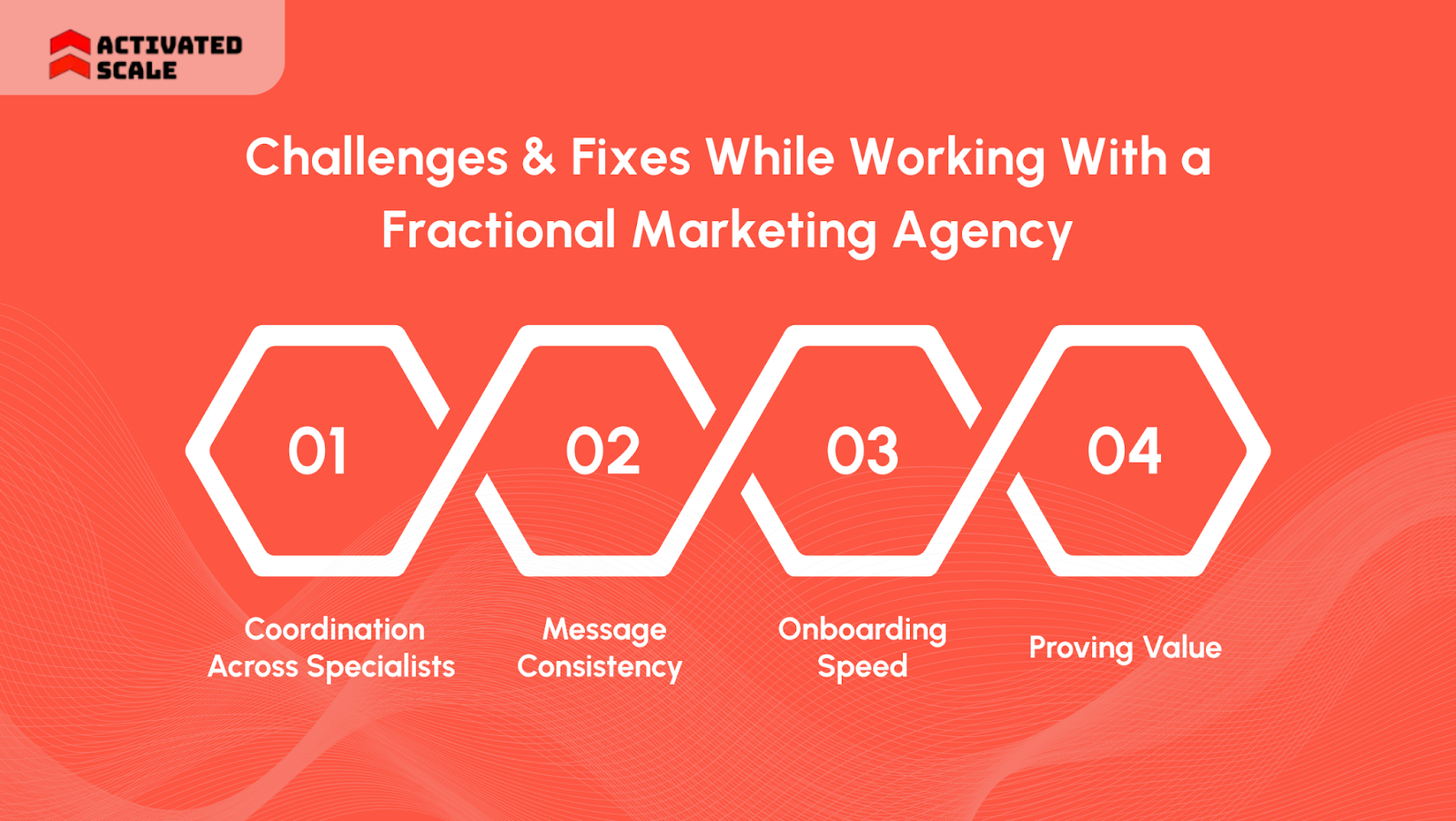
Let's be real: The flexibility of a fractional model requires a different kind of management. The potential pitfalls are predictable and entirely solvable. With these proactive fixes, you can sidestep the common headaches and fast-track to results.
Here’s how:
1. Coordination Across Specialists
When working with a marketing agency, different specialists may manage separate functions (SEO, content, paid ads). This can lead to confusion or misalignment.
Solution: Designate one project owner or team lead. This person will serve as the point of contact and ensure all strategies and efforts are aligned with the business goals.
2.Brand/Message Consistency
Keeping a consistent voice across all marketing channels can be tough when working with external teams.
Solution: Create a comprehensive brand guide that includes tone, messaging, visuals, and templates. Share this guide along with assets like logos, fonts, and color palettes to ensure cohesion across all platforms.
3. Onboarding Speed
Onboarding fractional teams can take time, especially if your team lacks detailed documentation.
Solution: To speed this process, prepare a starter kit with all necessary information, including ideal customer profiles (ICP), buyer personas, product details, and marketing history. A well-organized onboarding process helps get the team up to speed quickly and minimizes delays.
4. Proving Value
Measuring the ROI of fractional marketing efforts can be tricky without clear benchmarks.
Solution: Establish a baseline for all metrics before starting and agree on time-boxed tests to measure success. You can assess the impact more effectively and make informed decisions about future investments by running campaigns.
Ready to overcome these challenges and accelerate your marketing growth? Learn how our Contract-to-hire Sales Recruiting service can help you drive consistent results and scale effectively. Let’s turn your marketing hurdles into stepping stones for success with Activated Scale!
One Final Thought
Forget the old choice between a costly hire and a slow-moving agency. The fractional marketing agency is about using marketing as a precise tool. Yes, it requires a shift in management.
However, by choosing the right partner and mastering collaboration, you’re not only saving money. You’re gaining the one thing every growth-stage company needs: The power to pivot at a moment's notice.
You don't have to slow down to afford great marketing. Let's build a revenue engine that's as ambitious and agile as you are. Book a Call with Activated Scale
FAQs
1. How do fractional marketing agencies charge for their services?
Most fractional agencies offer flexible pricing models such as monthly retainers, project-based fees, or hourly rates. It’s essential to discuss terms upfront to ensure clarity on costs and expected deliverables.
2. How do fractional marketing agencies integrate with my current team?
Fractional marketing agencies often work alongside in-house teams and integrate through shared tools and clear ownership of deliverables. Expect smooth onboarding with a shared set of goals.
3. Can a fractional marketing agency handle large-scale projects?
Yes, many fractional agencies specialize in scaling businesses, product launches, or entering new markets. The flexibility of fractional models allows agencies to scale their involvement to fit the project’s needs.
4. How do I measure the success of a fractional agency?
Success can be measured through clear KPIs like lead generation, ROI, and campaign performance. Most agencies set baseline metrics and time-boxed tests to ensure their work aligns with your growth goals.
5. What if my marketing needs change mid-project?
One of the advantages of working with a fractional marketing agency is flexibility. You can adjust scope, roles, or priorities as your business evolves. Discuss potential changes with your agency to adjust deliverables or timelines accordingly.
The Ultimate Guide to Hiring a Salesperson!
Get the step-by-step guide to hiring, onboarding, and ensuring success!
_edi.png)

